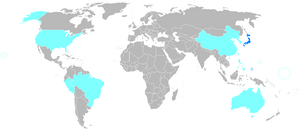Japanese language facts for kids
Quick facts for kids Japanese |
|
|---|---|
| 日本語 Nihongo | |

日本語 (Japanese language)
|
|
| Pronunciation | nihoŋɡo |
| Native to | Majority: Japan |
| Native speakers | 130 million/ (date missing) |
| Language family | |
| Writing system | Hiragana, Katakana, Chinese characters, romaji, Siddham script (occasionally in Buddhist temples.) |
| Official status | |
| Official language in | |
| Regulated by | None Japanese government plays major role |

The primary official language is Japanese. Japanese is a minority language.
|
|
The Japanese language is spoken by about 130 million people, mostly in Japan. It is very different from English and many other languages you might know. For example, in Japanese, sentences don't always need a subject. Also, adjectives can change to show if something happened in the past.
Contents
History of the Japanese Language
We don't know much about when the Japanese language first appeared. Some old Chinese writings from the 200s AD mention a few Japanese words. But we don't see many full Japanese texts until the 700s. During the Heian period (794–1185), the Chinese language had a big effect on Japanese words and sounds.
How Japanese Sentences Work
Japanese uses three different ways of writing. These are hiragana, katakana, and kanji. Hiragana and katakana are phonetic systems. This means they show how Japanese words sound. Kanji are Japanese versions of Chinese characters. These characters show the meaning of Japanese words.
All three writing systems are used together. You can often find them all in the same sentence! Each system is used for different things. In English, the order of words is very important. Think about "Is it?" versus "It is." In Japanese, these differences are often made by changing the endings of words.
Japanese speakers often use a person's title instead of words like "you." For example, when talking to your teacher, you would say sensei (先生, teacher). It would not be polite to use anata (which means "you"). This is because anata is used for people of the same or lower social standing. Your teacher has a higher standing.
Politeness in Japanese
The Japanese language has different ways to show social status. This means how polite you need to be changes. Your politeness depends on things like a person's job, age, or experience. It can even depend on how you are feeling. For example, if you are asking for a favor, you would speak more politely.
The person in a lower social position is expected to use polite speech. The other person might use a more common way of speaking. Strangers also speak to each other politely. Japanese children usually don't use polite speech until they are teenagers. At that age, they are expected to start speaking more like adults.
Learning Japanese as a Foreign Language
Many big universities around the world offer Japanese language classes. Some high schools and even elementary schools also teach Japanese. This is very different from before World War II. In 1940, only 65 Americans who were not of Japanese background could read, write, and understand Japanese.
People around the world became more interested in Japanese in the 1800s. This interest grew even more after Japan's economy boomed in the 1980s. The global popularity of Japanese popular culture also helped. Things like anime and video games became very popular in the 1990s. In 2012, almost 4 million people worldwide were studying Japanese.
In Japan, over 90,000 foreign students studied at Japanese universities and language schools in 2003. This included 77,000 Chinese students and 15,000 South Koreans. Also, local governments and some groups offer free Japanese classes for people living in Japan from other countries.
Images for kids
-
A 12th-century scroll showing a scene from The Tale of Genji, an 11th-century story.
See also
 In Spanish: Idioma japonés para niños
In Spanish: Idioma japonés para niños






